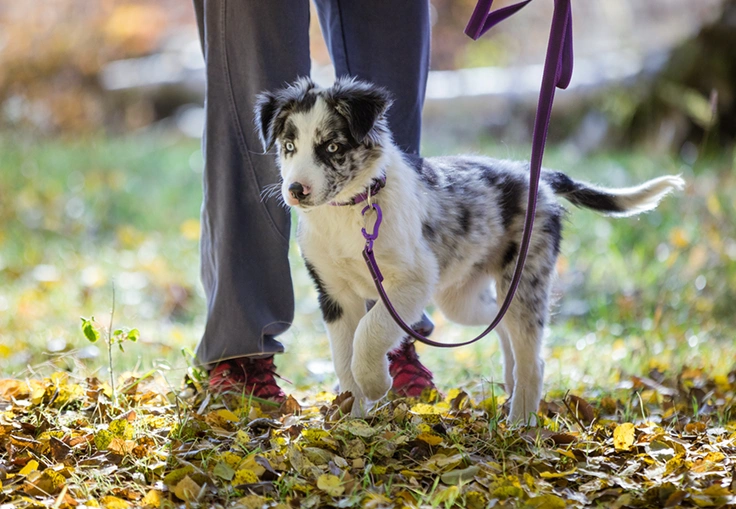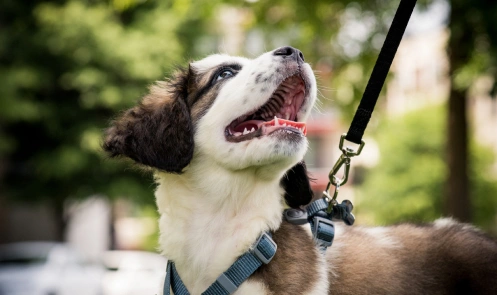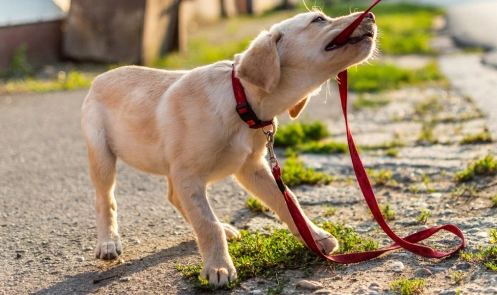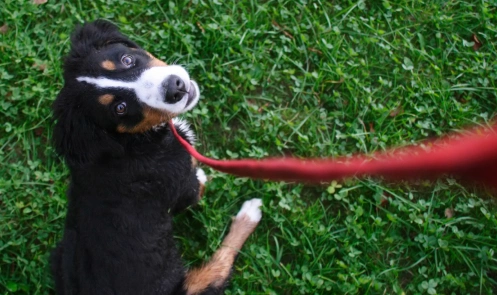Learn : Behavior & Training
How to Leash Train Your Puppy
How to Teach a Puppy to Walk on a Leash
Oh, puppy’s first walk. The excitement! The curiosity! The constant picking up unsavory objects with their mouths! Every step is an adventure.
It’s also an all-new experience that often comes with challenges. Puppies may pull or get distracted by every sound. And see above about garbage grazing. So how can you set the stage for a lifetime of walks together that are actually enjoyable, not a relentless struggle?
“A leash is a powerful form of communication between dog and person,” says licensed trainer Fred Zorn of Fred Zorn Dog Training. “The language of the leash is all about tension and release. It demonstrates to a dog who — and what — they should be paying attention to, and sets context for good and bad behavior.”
In other words, leash training can be used to help teach essential life skills, and to structure safe and enjoyable walks for both you and your little.
___________________________________________________________________________________________________
Essential Tools for Leash Training
Before starting leash training, it’s important to have the right tools to set your puppy up for success. Here are some must-have items:
-
Flat Collar – A standard collar that holds your puppy’s ID tags and can be used with a leash for training. Ensure it fits snugly but comfortably.
-
Front-Clip Harness – This type of harness discourages pulling by redirecting your puppy’s movement toward you.
-
Head Halter/Gentle Leader – Useful for strong or excitable puppies, a head halter allows you to make gentle corrections that reduce strain on a pulling puppy’s throat.
-
Six-Foot Leash – A standard-length leash provides enough freedom for movement while still allowing you to maintain control.
-
Treat Pouch – Having high value treats (like pure protein jerky from Nom Nom) readily available makes rewarding good behavior easy and consistent.
Introducing Your Puppy to the Collar and Leash
Your puppy’s first introduction to a collar or harness should be a positive experience.
-
Ensure a Proper Fit – The collar or harness should be snug but not tight, allowing two fingers to fit between the strap and your puppy’s body.
-
Let Them Wear It Indoors – Allow your puppy to wear their collar and leash around the house so they get used to the feeling.
-
Use Positive Reinforcement – Offer treats and praise to create a positive association with wearing their gear.
By making the collar and leash feel comfortable, your puppy will be more receptive to training sessions.
Teach Your Dog a Cue for Attention
Before heading outside, it’s important to teach your puppy to focus on you. “You can’t teach a lesson to a class that’s not paying attention,” Zorn says.
Establishing an attention cue will help redirect your pup’s focus when distractions arise.
-
Choose a Sound – A clicker, verbal cue (“yes”), or tongue click works well.
-
Mark and Reward – Say the cue and immediately give a treat when your puppy looks at you.
-
Practice in a Quiet Space – Reinforce this behavior indoors before adding distractions.
A strong attention cue ensures your puppy stays engaged with you on walks.
Encourage Your Puppy to Follow You
Encouraging your puppy to follow you naturally builds engagement and reinforces good walking habits.
-
Take a Few Steps Back – When your puppy follows, reward them with a treat.
-
Use Verbal Praise – Saying “good dog” reinforces the behavior.
-
Keep Sessions Short – Puppies have short attention spans, so keep training fun and brief.
This exercise teaches your puppy that staying close to you is rewarding. “There are five main forms of rewards when it comes to training, and food/treats are just one of them,” Zorn explains. “Play, attention, affection and freedom are all rewards for desired behavior, and can all play important roles when it comes to teaching leash walking.“
Practice Walking Indoors With Your Puppy First
Starting leash training indoors helps minimize distractions, allowing your puppy to focus.
-
Walk in a Quiet Room – Choose an area with minimal distractions.
-
Use a Marker Word – When your puppy walks beside you, say “good” and reward them.
-
Frequent Rewards – Reinforce the behavior by treating often.
Once your puppy is comfortable walking indoors, it’s time to take training outside.
Take Leash Training Your Puppy Outdoors
Outdoor training introduces new sights, sounds, and smells, making it a big step for your puppy.
-
Start in a Quiet Backyard – This minimizes distractions and builds confidence.
-
Keep Walks Short – Begin with five to ten-minute sessions.
-
Reward Focus – When your puppy checks in with you, reward them to encourage engagement.
With consistency, your puppy will learn to focus on you even in new environments.
Prevent Your Dog from Pulling on Their Leash
Pulling is one of the most common leash-training challenges, but it can be managed with the right techniques. “The most important? Making sure pulling doesn’t work for them,” stresses Zorn. “It shouldn’t get them what they want, or take them where they want.”
-
Stop Moving – If your puppy pulls, stop walking and wait until they loosen the leash before continuing.
-
Use a Front-Clip Harness – This can help reduce pulling by redirecting your puppy’s movement.
-
Reward Loose-Leash Walking – When your puppy walks with slack in the leash, offer praise and treats.
By being consistent, your puppy will learn that pulling doesn’t get them where they want to go.
Redirect Lunging and Barking on Their Leash
If your puppy lunges or barks at distractions, redirecting their focus is key.
-
Recognize Triggers Early – Notice signs that your puppy is about to lunge, such as stiffening or intense staring.
-
Use Treats to Redirect – Offer a high-value treat before they react to the trigger.
-
Increase Distance if Needed – If your puppy remains reactive, create more space between them and the distraction.
With time, your puppy will learn to focus on you instead of reacting to distractions.
Increase Distractions Gradually
Once your puppy is comfortable in quiet areas, it’s time to introduce more distractions.
-
Progress Slowly – Move from quiet neighborhoods to busier streets gradually.
-
Change Directions and Speed – This keeps your puppy engaged and responsive.
-
Reward Focus – Reinforce attention on you, even in busy environments.
Gradual exposure helps your puppy adapt to different walking scenarios.
___________________________________________________________________________________________________
Conclusion
Leash training a puppy requires patience, consistency and positive reinforcement. By using the right tools, introducing the leash gradually and reinforcing good walking behaviors, you’ll set your puppy up for success.
“It’s a lot less about the person maintaining control, than teaching a dog self control,” explains Zorn. “Understanding which leash behaviors produce desired results for them — whether it’s getting to sniff a tree, making it to the dog park, or receiving a delicious treat — will in turn produce desired results for you.”
For more helpful insights on leash training a puppy, check out Fred Zorn's animated training video!






 The Importance of Crate Training Dogs
The Importance of Crate Training Dogs
 Dog Training Basics
Dog Training Basics